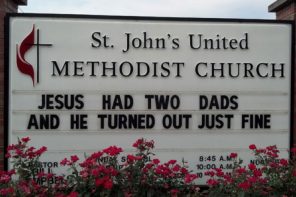Some of you may have noticed the recent flurry of reports about the physicists in Europe who think they’ve caught some rowdy subatomic particles breaking the cosmic speed limit. Scientists at CERN suspect that a flock of neutrinos arrived at their destination 60 nanoseconds earlier than they should have. That may not seem like much time—the blink of an eye is millions of times longer—but for physicists and maybe for us too, it is all the difference in the world.
What is at stake is Einstein’s theory of special relativity and the mountain of solid science that depends on it. One of relativity’s central ideas is that nothing can travel faster than light. Related to this idea are a host of counterintuitive (and experimentally verified) results. Time and space are relative and not absolute. Your one mile is not one mile for everyone. Your one second is not one second for everyone. Twins, taking different paths through space and time, can rejoin one another only to discover their ages to be years apart.
What’s more, the order of events can actually be inverted as seen from different points of view. Say I stomp my foot in Atlanta and you stomp yours a short time later in San Francisco. Some observers will detect my stomp first, and some will detect your stomp first. Neither is wrong, because for such pairs of events there is no “real” order. This is not a matter of mere appearances or light travel times or time zones, but is part of the way the universe is put together. In general, the ordering of events is relative.
As Dave Barry says, I am not making this up.
To sober up and qualify things a bit: For the sequence of any pair of events to be inverted, they cannot be, even in principle, causally related. That is, no one could observe you at your first birthday party before they observe your birth. As strangely as time and space may be bent, they cannot be twisted so far that effects precede their causes, for any observer.
But this is true only so long as everyone plays nice and obeys the cosmic speed limit. If those European neutrinos really did arrive at their destination 60 nanoseconds early, all bets are off. Causality goes on the block. And when that happens, everything goes, in the immortal words of Michael Binkley, “all higgeldy-piggeldy.” Think Back to the Future. Think Terminator. Think Ghostbusters: “Cats and dogs, living together!”
This brink-of-pandemonium flavor of the CERN report has been noted by many members of the Fourth Estate, some of whom see theological consequences. Just a few days ago, Charles Krauthammer wrote the following:
There must be some error. Because otherwise everything changes. We shall need a new physics. A new cosmology. New understandings of past and future, of cause and effect. Then shortly and surely, new theologies.
Perhaps he is right. But I have my doubts about the “shortly and surely” part, because cause-and-effect and other human intuitions about the world have long been challenged within physics. And, with the exception of a small handful of thinkers such as John Polkinghorne, few theologians have noticed.
For decades physicists have had to confront something called quantum nonlocality. Quantum nonlocality does not violate relativity as would the faster-than-light neutrinos, but it does raise serious questions about how the world is interconnected. It suggests rather strongly that events in one location may, under certain circumstances, have instantaneous correlations at other locations (how “correlations” differ from “effects” is a tricky question). At the very least, quantum nonlocality radically challenges deeply-seated human assumptions about the nature of physical reality: What is real? Do particles have independent realities apart from our observations of them? If so, what does that mean? Hint: Not what you think.
There are other aspects of the physical world that should make us think twice about the nature of reality: conservation of mass-energy can be (and therefore must be) violated; tiny local changes can have global consequences; and necessary uncertainties can render these tiny changes impossible in principle to determine.
In other words, we don’t need faster-than-light neutrinos to convince us that physical reality is, in the recent words of Clay Farris Naff, “much weirder under the hood than it looks in the showroom.” What you see is not what you get.
Don’t misread me: The world we live in every day is not reducible to quantum weirdness. But certainly it’s not reaching too far to suggest that life on the macroscopic scale, or some aspects of it, may be somehow dependent on quantum weirdness. That every now and again some of the apparently nonlocal or non-energy-conserving or non-deterministic or uncertain-in-principle elements at the subatomic depths propagate up to the surfaces of the macroscopic world. Perhaps it is through such bottom-up cascades that God acts in the world. Perhaps it is through such that the miraculous may occur.
Full disclosure: I for one don’t look for science to reveal openings through which the divine hand might work. Not that I’m against those who look for such openings. But I think that Hamlet may as well have looked for an opening through which the hand of Shakespeare might have worked.
For those theologians who would look to science for such openings, however, theology does indeed have some catchup to do. And perhaps once that’s done it will be ready to address the CERN report, which will probably by that time be revealed to be non-reproducible.
Which, in the language of science, means “wrong.”



